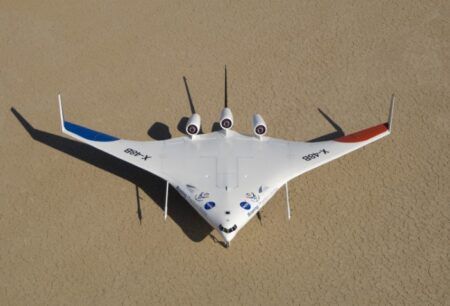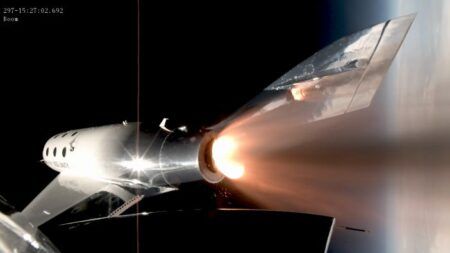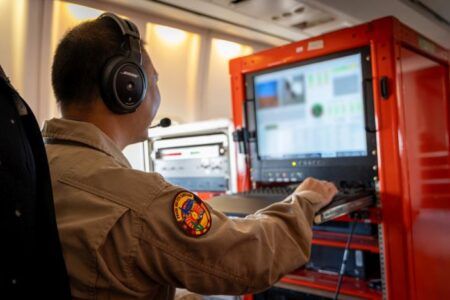How did your test career start?
After getting my degree in mechanical engineering, I started as an assistant test engineer at the Netherlands Aerospace Centre (NLR), managing R&D coupon test programs on composite materials. As an assistant, my job was to arrange everything needed to execute the test program, including design of test tooling and specimen manufacturing. From an assistant, I became a project engineer responsible for the execution of the test programs, planning and financial issues.
What was your first testing job?
NLR started full-scale testing with the certification test on the Fokker 100 tailplane in the 1980s. After the bankruptcy of Fokker in 1996, NLR took over the test department of Fokker. With this expansion of test activities, the certification test on the NH90 tail [designed and manufactured by Fokker Aerostructures] and several other certification test programs on smaller full-scale aircraft components, like the Dassault Falcon 7X aileron and rudder, became part of the NLR full-scale test portfolio. After the NH90 full-scale test setup moved from the Fokker site at Schiphol to the NLR site in Flevoland, I became project engineer of this test program in 2008 and was responsible for the restart of the actual testing at the new location. Right now, NLR is executing the full-scale test programs on the Dassault Falcon 5X tailplane and the flap tracks of the Bombardier C Series. Compared with the test on the Fokker 100 tailplane, which took place more than 30 years ago, the main difference is in the increased level of control, data acquisition and network technology. We can now handle and process large amounts of test data, which provides a better insight into the actual status of the test.
What was the most valuable lesson from those early days?
Full-scale testing is teamwork. Open communication with your team members and your customer is very important. Even when nothing is happening, tell your customer that nothing is happening. Getting commitment from your operators and subcontractors is vital to meet your deadlines. Furthermore, be sure that the expectations of your customer are always correct.
What is your current position and what does it involve?
As a project engineer I am responsible for the correct execution of test programs. Not only on full-scale test articles, but also on small coupons as tested to generate material data. These test programs are executed in the framework of commercial projects for aircraft suppliers and national and/or European research programs such as Clean Sky. A project engineer at NLR has multiple projects at a time in order to be fully occupied, and is responsible for technical, planning and financial issues. Besides the executing of projects, a project engineer also has to acquire new projects and customers.
Describe a typical day
Running a full-scale test program is a dynamic event. During fatigue testing it can be relatively quiet, especially when no deviations are observed. However, when the limit load and ultimate load test campaigns are on the schedule, things can be really hectic and intense.
A typical day starts with checking the progress of the test campaigns; meetings with the operators to check if there are any anomalies; updating the documentation; and briefings with the customers. And there are always issues that need to be checked and re-arranged, or preparations to be made for the next test phase.
What are you working on right now?
Two large full-scale test programs are currently active: we are testing the flap tracks of the Bombardier C Series – three flap tracks in total; and we are carrying out a full-scale certification test on the tailplane of the Dassault Falcon 5X.
For both these programs, the greatest challenge is to execute a full-scale test program at the lowest possible cost. The major part of the budget is absorbed by the design and manufacturing of the test-rig. Because full-scale test articles are never identical, previous test frames can often not be reused. However, to keep costs down, we have been building test frames with pre-fab modular beams and rods. Bolted on a slotted concrete floor, a stiff and cost-effective test frame can be built. Only the local interface structure with the test article will then be a dedicated design.
We are also very focused on visualizing test data during the execution of the test program. By broadcasting the test data over a secure network, we offer customers the possibility to semi-live-monitor their full-scale test. By using templates, NLR reduces post-processing and reporting efforts for the customer.Tell us about the NLR’s unique facilitiesOur biggest advantage is that NLR is a one-stop shop.
We can take care of every aspect of a structural test program for the customer, from test-rig design, manufacturing, assembly and test execution, to generating test loads, data analysis and assistance with certification regulations.
We are also proven specialists in non-standard testing. For testing at extreme low temperatures or in extreme environments, we design and build test rigs that are able to meet extreme test goals.
For the test campaign on the Bombardier C Series flap tracks, part of the endurance testing was conducted at -55⁰C. For this purpose, we designed and built a mobile climate chamber based on vaporizing liquid nitrogen. It had to be mobile because it had to be used in three test frames. It was successfully used during 24/7 testing of all three flap tracks.
Furthermore, NLR designed and built a portable impact system for application of impact damages in, for instance, full-scale composite structures. At locations that are normally difficult to reach, impact damages can be applied in a controlled way with this device. Onboard data acquisition measures the applied impact energy. We have already sold a few of these portable impact devices to several aircraft manufacturers all over the world.
What are you doing to support the RNLAF’s F-16s?
Besides the regular load monitoring activities of NLR’s Structural Health Monitoring team, we tested a wing set of one of the RNLAF’s F-16s in 2014. The main question from the Netherlands Air Force was whether it had to order a new set of wings for its current fleet of F-16s, while awaiting the delivery of its first F-35s [The Dutch Parliament approved an order for eight Lockheed Martin F-35As in March 2015, confirming the aircraft as the official replacement for the F-16 for the Royal Netherlands Air Force]. This potential purchase of new wings for its F-16s would obviously represent a major investment for the air force.
From a wing set with a known history, one wing was dismantled (tear-down inspection) to record the actual status, while the other was subject to an extensive full-scale test. NLR built a test setup with 21 hydraulic actuators loading the wing with a representative load sequence, including loading of fuel tank and armory interfaces.
After testing the wing until the end of its fatigue life and analyzing the test data, it was concluded that the purchase of a new set of F-16 wings was not necessary as the existing set of F-16 wings would last until the arrival of the F-35.
How long is a typical full-scale test and what does it involve?
Assuming that there are no delays, a typical certification full-scale test on, for instance, a tailplane lasts about 18 months, starting with compilation of the test plan. The following activities can be identified for such a test (in chronological order): test rig design; instrumentation of test article parts at the customer’s production site; fabrication and installation of the test frame; completion of the instrumentation of the test article; installation in the test rig; shake-down and strain verification testing; fatigue test campaign; static test campaign (limit and ultimate load cases); damage tolerance test campaign (fatigue); and residual strength test.
The test article itself is equipped with hundreds of strain gauges. As well as strains, deflections, applied loads and reaction loads are also measured. At NLR, data is captured 24/7 in a binary file, even when the test is not running. Out of this binary file, data sets are taken for analysis. During a first quick check, the critical sensors are analyzed and the data is checked for minimum/maximum values. By performing regular checks, trends can be observed that might be an indication of damage development. In consultation with the customer, a sub-set of the data is visualized in graphs, which are accessible via a secure website. In this way, the customer can monitor the progress and the test data.
What is the largest rig you have built?
The largest full-scale test rig is the currently installed horizontal stabilizer of the Dassault Falcon 5X. In this setup, stabilizer and elevators are tested together with the elevator under different deployment angles. This full-scale test involved over 1,000 data channels and the most advanced data acquisition setup. However, the test rig with the largest number of actuators [21] and the highest load levels was the full-scale test on the F-16 wing.
But the test program with the most advanced test concept and load control configuration is the Bombardier C Series test campaign. In this setup, the applied air load on the carriage is the result of vector decomposition as a function of the flap angle. Furthermore, hydraulics are combined with electrical actuation. The fatigue program is conducted flight-by-flight, in realistic environmental conditions [dirt, temperature at -55⁰C].
At the moment, building activities are ongoing for a new increased test site with 880m2 of floorspace, of which 600m2 is reinforced and slotted. This will provide enough space to test six Dassault Falcon 5X horizontal tailplanes at the same time. The new facility will be fully air-conditioned at 23⁰C, and will have a total test volume of 9,000m3. The new test site, at the NLR location in Flevoland, will open in the second half of 2017.
How has structural testing changed?
The evolution of computer technology has made load control, data acquisition and computer network systems incredible powerful. Data from load control and data acquisition systems is now stored in databases 24/7. With scripting software, data can be extracted from these databases, analyzed, presented online in clear overviews, together with the predictions, and broadcast over secured networks, in order to monitor the test from any location. With current optical measurement systems, strains, deflections and positions of large areas [field data] can be collected in one instance to support local readings. Compared with 10 years ago, the potential to monitor tests and extract as much data as possible has increased tremendously.
Do you test to the point of failure?
For a national research program we tested a G650 horizontal stabilizer partly made of thermoplastic composite. At the end of the test program, the aim was to test the stabilizer until failure, but the test article was stronger and more flexible than expected. We ran out of stroke on the actuators and were not able to test to rupture, although we reached 240% of limit load.
How have you improved test efficiency?
By visualizing test data during the entire test program and direct comparison with predictions, we can reduce the lead time of a static test campaign. By using the reporting templates of the customers, which are filled with test data by NLR, the reporting effort of the customer is reduced. We receive a lot of positive response from customers about the fact that their test report is more or less ready right after the actual test is finished.
Will simulation ever replace testing?
No doubt models and simulation techniques have been improved and will improve further. It’s also true that during execution of full-scale test campaigns, we have noticed that the customer’s predictions are fairly good. But there are always details in the design that are not covered, or only partly covered, by calculations. In every model, assumptions have to be made for some design parameters. With testing, the models can be tuned and improved. In future, the number of tests, and the scale of them, will reduce, but testing will be needed to ensure a safe flight.
Anthony James is Editorial Director for UKIP Media & Events, which publishes Aerospace Testing International magazine.
This article was also published in the December 2016 issue of Aerospace Testing International magazine.




